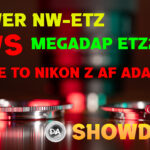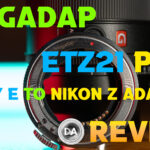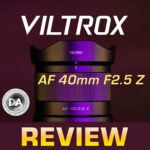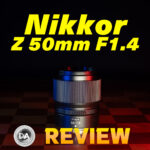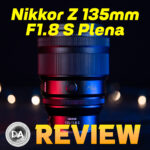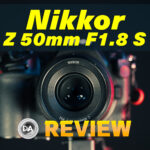
Neewer NW-ETZ Adapter Review
When I first started using Sony E-mount, I was coming off a period of more than a decade where I had used the Canon EF ecosystem exclusively. It was a delight to find that there were adapters that would allow me to use my Canon lenses on my Sony camera as well. I used and reviewed a number of popular adapters from brands like Metabones, Sigma, and Vello, but found that they all came with some serious limitations. Over time I tired of used my EF lenses adapted for two primary reasons: 1) size and weight. 2) Inadequate performance. My favorite of the adapters proved to be the Sigma MC-11, but it added 125g to the weight of every lens attached to it and added another 26mm in length. This was necessary to adapt a DSLR mount to a mirrorless design. The optical path needs to be in a completely different place, so the optics need to be moved further away from the sensor to achieve proper infinity focus. I found that there was a huge spectrum of performance, too, with some lenses working fairly well and others being very inconsistent. Video AF, in particular, was pretty rough where it existed at all.
But over a series of reviews, I’ve been looking at very different types of adapters that now adapt one mirrorless lens mount (Sony E-mount) to another mirrorless lens mount (Nikon Z-mount). The rules are a bit different this time. For one, the “flange distance” between the two mounts is similar, so now the adapter itself is just a few millimeters thick (2mm, to be exact), adding almost no additional bulk to lenses. There is a bit of weight, but, at 46g on my scale, it’s a third of what we dealt with the EF to FE adapters. In my tests, the Megadap EZ21 Pro has a few advantages over the Neewer NW-ETZ that I’m, reviewing today, but also costs about $100 more. So is the Neewer NW-ETZ and its $160 price a better choice if you’re on a budget? Find out my thoughts by watching the video review below…or just keep reading.
Follow Me @ YouTube | Patreon | Instagram | Facebook | DA Merchandise | Flickr | 500px | X
__________________________________________________________________________________________________
Thanks to Neewer for providing a review sample of the NW-ETZ. As always, this is a completely independent review. All opinions and conclusions are my own. *The tests and most of the photos that I share as a part of my review cycle have been done with the 45MP Nikon Z8, which I reviewed here.
__________________________________________________________________________________________________
There will be some continuity between this review and another of the Megadap ETZ21 Pro, as I’ve spent time with both in an attempt to get up to speed as to which adapter works better.
There are two versions of the NW-ETZ adapter; a regular version (like the one I’m testing here) and a Pro version that costs about $20 more. The primary difference to the Pro version seems to be the inclusion of a weather sealing gasket, which is a negative point I raised about the Megadap adapter in my review of that lens.

For some reason, however, user reviews tend to be higher for the cheaper adapter without the rubber gasket. Perhaps the fit is a little better without it, as functionally these should be the same.
The premise of the NW-ETZ adapter is pretty simple – it interprets the focus algorithms from the camera (Nikon Z) and translates them to the language of the lens (Sony E), and carries EXIF data and focus information back to the camera. The byproduct is that you can get effective autofocus from Sony E-mount lenses on a Nikon Z mount body…and there’s a lot of great Sony E-mount glass out there!

So does it work? The answer is a little more complicated than what I saw with the Megadap ETZ21 Pro in my review, as I saw a wider variety of performances. Initially, I actually thought that it might work better for stills, as I found that autofocus with the first two lenses that I used (Sony FE 35mm F1.4 GM and Tamron 35-150mm F2-2.8 VXDE) was arguably better than the Megadap.

But as I expanded out the pool of lenses that I used, I found that my results varied more widely. I’ll detail more about that in the review below.
Build and Design
As noted previously this is a pretty simple device in some ways. Essentially it feels like a metal lens mount detached from a lens.

At just 2mm thick, it essentially just goes onto the lens like a second mount.

You really won’t notice that the adapter is there once mounted, and I found that in the half dozen lenses that I tested with it, mounting and unmounting lenses remained relatively simple. The fit of lenses will vary a bit, with some being tighter than others, but I never felt like I really had to force things.The adapter is very, very thin. Always be sure to power down the camera before removing anything, however.
The release mechanism is different from the Megadap’s, as that release needs to be depressed while the NW-ETZ requires sliding the mechanism clockwise.

The magic of the adapter is the dual sets of electronic contacts front and back. On the backside you will see the electronic contacts for communicating with the Nikon camera. There is a second set of contacts that says, “Update” above it, and this is for doing firmware updates. There is an included cable that magnetically attaches to the larger circles and then data is transferred to the adapter. The other end of the cable is a USB-A connector.

I did do a firmware update, and found that the magnetic attachment wasn’t quite as strong as what I would have liked. You need to be sure that the cable doesn’t hang down in between the adapter and your computer, as it will pull the contacts away from having a firm connection. I actually held the cable tight to the adapter during the review.

The actual update was just a matter of dragging the firmware update file into the folder for the adapter that pops up once the connection is made. There isn’t really any kind of reaction, but if you let it sit for a minute, then eject the folder and reconnect, you’ll find that the update has in fact happened.
The front of the adapter has the pins that will come in contact with the Sony E-mount lenses.

Presumably there is some kind of processor hidden in there to do the focus algorithm conversions.
The Megadap adapter definitely bests the Newer in one regard: it accurately delivers the EXIF information, whereas the Neewer seems to try to find a Nikon equivalent.

Both of the images in the comparison were shot with the Tamron 35-150mm F2-F2.8 VXD, and the Megadap shows the proper lens designation (including A058, Tamron’s internal code for the lens), while the Neewer reported VR 35-150mm F2-2.8G, which is clearly not accurate (this is not a G lens, nor does it have VR). The Megadap also reported properly for the two Sony lenses I tested, the Sigma lens, and the Viltrox lens. The Neewer reported the Sony lenses as VR 35mm F1.4G and VR 50mm F1.4G, while the Megadap properly recorded them as FE 35mm and 50mm F1.4 GM, respectively.

Still, for a relatively low amount of money, you can mount your E-mount lenses on your Nikon camera and enjoy autofocus.
Manual Focus Aids?
The Neewer NW-ETZ has an additional trick up its sleeve that the Megadap lacks. If you attach manual focus lenses (even those without electronic contacts), the NW-ETZ serves to provide electronic communication, giving you focus confirmation and even allowing Nikon’s focus guide to work (which prompts you which direction to turn the manual focus ring to achieve proper focus).

I had a lot of fun with my Thypoch Simera 28mm F1.4 (an M-mount lens), but utilizing an adapter from M-mount to E-mount, and then using the NW-ETZ to complete the journey to Z-mount. It was easy to nail focus, and the focus confirmation proved very accurate.

You can see just how precise that focus was here:

Somewhat disappointing, however, is that even while my Z8 camera allows me to manually enter the EXIF information for a lens like this (and I went to the trouble to do so!), the adapter reported the lens as 50mm F1G – not correct in any detail!
But this was unquestionably a nice hidden feature, as this worked for any fully manual (no electronics) lens that I tried, whether it was E-mount, M42, or M-mount. Just use an additional adapter to E-mount (if needed), and the NW-ETZ provides the electronics. Pretty cool!
Stills Autofocus with the NW-ETZ
When reviewing the Megadap ETZ21 Pro, I found that my focus results were pretty consistent. Lenses with faster focus motors focused faster, obviously, and more confident autofocusing lenses worked better at the extremes. My findings are more nuanced with the NW-ETZ, as some lenses worked fantastically, while others didn’t really work particularly well.
I tested the Sony 35mm and 50mm F1.4 G Master lenses, the Tamron 90mm F2.8 Macro, 28-200mm RXD, and the 35-150mm VXD, the Sigma 85mm F1.4 DN, and the Viltrox AF 16mm F1.8 and 135mm F1.8 LAB.
What’s wild is that my results were not consistent within brands. Let’s start with the two Sony lenses. The 35mm F1.4 GM works pretty much like a native lens, with fast, accurate results.

The very similar 50mm F1.4 GM behaved very differently. It focuses slowly and gradually, and with close focus targets I almost exclusively got results like this:

I would have to use manual override (which works great on Nikon, by the way) to get focus in the right zone, where autofocus would mostly do its job, getting me this properly focused result.

So your perception of the adapter is really going to depend on which lens you have attached to it. My initial impression (based on the 35mm) was the Neewer adapter might be better than the Megadap, but when I switched the 50mm, I was changing focus options, checking connections, and wondering if I was using the same adapter.
So, on the positive list. Outside the 35mm GM, I had very good results with the Tamron 35-150mm VXD. We used the combination for a church service and baptism, and I got fairly similar results to what I would have gotten normally with the lens on a Sony body. Very slightly slower, perhaps a hair less accurate, but perfectly usable.



The Tamron 90mm F2.8 Macro VXD also worked brilliantly, delivering results not far from what I would expect from a native lens.



I even found that I didn’t have the issues with focus not wanting to grab a foreground subject, so in this regard I found that it worked better than what I saw with the Megadap.
But when I put the Tamron 28-200mm RXD, I got absolutely terrible results, with focus basically not happening regardless of what I did to try to coax it along. I basically was resorting to manual override to get anything in focus.



In the case of Tamron lenses (at least the three I tested), it seems like the adapter likes the newer VXD motor, but doesn’t like the older RXD motor of the 28-200mm.
Ironically, however, the STM focus motor of the Sigma 85mm F1.4 DN (definitely not the latest and greatest technology) worked fine, with the Sigma delivering good speed and precision.



Finally, the Viltrox 16mm F1.8 worked perfectly, delivering accurate results even against strong backlighting.

The new 135mm F1.8 LAB lens sports a VCM motor that is similar in technology to the Tamron VXD focus motor, but the 135 LAB refused to focus at all, instead emitting a whine and refusing to do anything.
In the video review you can see my formal tests with the 35GM and 50GM, and how radically different the result with these two similar lenses is.
In other words, the results were all over the map. When a lens works on the Neewer NW-ETZ, it tends to work really well, but results are obviously much more inconsistent. It’s still generally true that better focusing lenses are going to make the transition better. That makes sense, as really the adapter’s job is to send the correct communications from the lens to the AF system via the contacts, so a fast focusing lens should continue to be a fast focusing lens, with the only real slowdown being from the need to “reinterpret” the focus algorithms from one language (Sony) to another (Nikon). The wild card in the mix here is that a fantastically focusing lens like the Sony FE 50mm F1.4 GM isn’t really all that great via the Neewer adapter, but was pretty great via the Megadap adapter.
Now, to be fair, you could eventually get the focus results you wanted with most lenses (save those that just really refused to work), like this lovely shot with the 50GM below.

But in many situations I felt like I could achieve greater success with the Megadap adapter.
Video Autofocus
*These results will be easier to see in the video review for obvious reasons.
The good news is that if you have a lens that focuses well for stills, you will also get fairly decent video AF. I did a series of test with the two GM lenses, and found that AF didn’t pick me up at all as I walked towards the camera with the 50mm F1.4 GM attached via the NW-ETZ.

With the 35mm F1.4 GM the combo tracked me perfectly, and even quickly picked me when I stepped out and back into frame.

I then tested focus pulls with the more functional lens (35GM), and found that I could generally get decent focus pulse, but I found that I encountered more pulsing during focus pulls, which is generally a byproduct of focus not being confident enough to lock.
So, as before, you’ll get your best results for video AF when using more confident lenses. I wouldn’t call video AF “native” in performance, but I would call it good enough…so long as you are using one of the lenses that the adapter likes.
Conclusion
Switching to a new camera brand can be a daunting experience, as the sheer cost of selling what you have (typically at a significant loss) and then rebuying everything for the new brand is expensive. The Neewer NW-ETZ is an inexpensive ways to bridge that gap. You can keep using the lenses you love without adding any bulk and only minimal weight, and that weight is right up close to the camera where you won’t notice it anyway. I also really like the potential benefit for manual focus lenses and the idea of getting a focus confirmation chip as a free bonus.

After a stellar start, I was disappointed that I got somewhat inconsistent results as I widened my pool of lenses. On the lenses where the adapter worked well, it worked really well, delivering fast, accurate autofocus.

But in other cases, I was obviously much less impressed. The Megadap seems like the safer choice to me, though you will have to pony up an extra $100. Perhaps that’s because the Megadap is two generations in, while this is Neewer’s first shot. I think there’s a lot of potential here, because when it works, it works really well, but there are definitely some bugs left to squash.

Pros:
- Love how compact the adapter is
- Manual focus electronic confirmation is a nice bonus
- Autofocus for stills (with lenses it likes) is generally very good
- Was able to track some action during video capture
- Ongoing support via firmware
- Very reasonable price
- Option to get weather sealing
Cons:
- Very inconsistent performance from lens to lens
- Incorrect EXIF lens information
- Firmware update cable doesn’t attach well
_________________________________________________________________________
GEAR USED:
Purchase the Neewer NW-ETZ @ Neewer | B&H | Amazon | Amazon Canada | Amazon UK | Amazon Germany
Purchase the Megadap ETZ21 Pro @ B&H | Adorama | Amazon | Camera Canada | Amazon Canada
_______________________________________________________________
Purchase the Nikon Z8 @ B&H Photo | Adorama | Amazon | Camera Canada | Amazon Canada | Amazon UK | Amazon Germany
_________________________________________________________________
Want to support this channel? Use these affiliate links to shop at: B&H Photo | Amazon | Adorama | Camera Canada | Amazon Canada | Amazon UK | Ebay | Make a donation via Paypal
Buy DA Merchandise https://bit.ly/TWIMerch

Keywords: Neewer, NW-ETZ, NW-ETZ, Megadap, ETZ21 Pro, Sony, E-mount, Adapter, Megadap Review, ETZ21 Review, Pro, ETZ21, Z, Z-mount, Z8, Review, mirrorless, Full Frame, Sports, Tracking, Dustin Abbott, Real World, Comparison, Handling, Focus, Portraits, Resolution, High ISO, Image Quality, Sample Images, Photography, 45MP, #letthelightin, #DA, #NIKON, #Z8, #NIKONZ8

